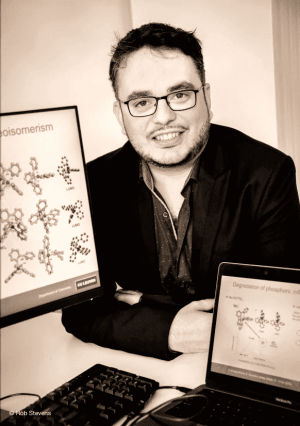- Start
- End
- Types of event
- CataLight Invited Talk
- Venue
-
IAAC
Humboldtstraße 8, Lecture Hall
07743 Jena
Google Maps site planExternal link - Speaker
- Prof. Dr. Daniel Escudero
- Organizer
-
GDCh Colloquium / CataLight SFB/TRR 234
- Language of the event
- English
- Wheelchair access
- Yes
- Public
- No
“In-silico” Modelling of Photoluminescence
Event details
Portrait Prof. Daniel Escudero
Image: Daniel Escudero Masa“In-silico” Modelling of Photoluminescence
Prof. Dr. Daniel Escudero
Department of Chemistry, KU Leuven, Celestijnenlaan 200F, 3001, Leuven, Belgium
In this contribution I present computational protocols to model photoluminescence in molecular systems which go beyond the nowadays routine modelling of emission energies. Our protocols merge state-of-the-art quantum chemical calculations, excited state decay rate theories
(i.e., Fermi-golden rule based) [1] along with semi-classical nonadiabatic excited state dynamics to enable the quantitative determination of excited state lifetimes and photoluminescence quantum yields.
In particular, I present protocols to model anti-Kasha fluorescence in molecular systems (i.e., fluorescence from higher-lying excited states), [2,3] but also to model intersystem crossing [4] and phosphorescence in Ir(III) complexes. [5] Finally, the first attempts to capturing fluorescence events in molecular systems within a semi-classical Non-Adiabatic Molecular Dynamics framework. [6]
These investigations contribute to our continuous efforts towards attaining quantitative determinations of photochemistry at the first principles level. By treating on equal footing radiative and non-radiative processes, our methods allow to attain a complete molecular movie of the excited-state deactivation.
[1] First-Principles Calculations of Excited-State Decay Rate Constants in Organic Fluorophores. M. T. do Casal, K. Veys, M. H. E. Bousquet, D. Escudero, D. Jacquemin, J. Phys. Chem. A, 127, 10033 (2023)External link
[2] Computational Protocol To Predict Anti-Kasha Emissions: The Case of Azulene Derivatives. K. Veys, D. Escudero, J. Phys. Chem. A, 124, 7228 (2020)External link
[3] Anti-Kasha Fluorescence in Molecular Entities: Central Role of Electron–Vibrational Coupling. K. Veys, D. Escudero, Acc. Chem. Res., 55, 2698 (2022).External link
[4] Modeling the Fluorescence Quantum Yields of Aromatic Compounds: Benchmarking the Machinery to Compute Intersystem Crossing Rates. K. Veys, M. H. E. Bousquet, D. Jacquemin, D. Escudero, J. Chem. Theory and Comput., 19, 9344 (2023)External link
[5] Phosphorescent Properties of Heteroleptic Ir(III) Complexes: Uncovering Their Emissive Species. P. Kumar, M. Pérez-Escribano, D. M. E. van Raamsdonk, D. Escudero, J. Phys. Chem. A, 127, 7241 (2023)External link
[6] The radiative surface hopping (RSH) algorithm: Capturing fluorescence events in molecular systems within a semi-classical non-adiabatic molecular dynamics framework. M. Pérez-Escribano, J. Jankowska, G. Granucci, D. Escudero, J. Chem. Phys., 158, 124104 (2023)External link
Background Information
Prof. Escudero is currently Assistant BOFZAP Professor in the Department of Chemistry, at the KU Leuven. Born in 1984 in Palma de Mallorca, he graduated in Chemistry at the Universitat de les Illes Balears, Spain, and obtained his PhD with honors in Chemistry at the Friedrich-Schiller-Universität Jena, Germany, in 2011. Following his PhD, he spent three years (2011-2014) at the Max-Planck Institut für Kohlenforschung, Germany and four years (2014-2018) at the Université de Nantes as a postdoctoral researcher. He is currently Head of the Quantum Chemistry and Physical Chemistry Division at the KU Leuven.
Source: https://danielescuderomasa.wixsite.com/website/teamExternal link
Contact
Department of Chemistry, KU Leuven, Celestijnenlaan 200F, 3001, Leuven, Belgium
E-Mail: daniel.escudero@kuleuven.be
Webpage: https://chem.kuleuven.be/en/research/qcpc/cpcExternal link
